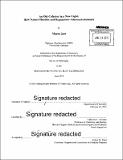An old cofactor in a new light : how nature handles and repurposes adenosylcobalamin
Author(s)
Jost, Marco, Ph. D. Massachusetts Institute of Technology
DownloadFull printable version (40.68Mb)
Alternative title
How nature handles and repurposes adenosylcobalamin
Other Contributors
Massachusetts Institute of Technology. Department of Chemistry.
Advisor
Catherine L. Drennan.
Terms of use
Metadata
Show full item recordAbstract
Adenosylcobalamin (AdoCbl, coenzyme B 12) is a complex organometallic enzyme cofactor derived from vitamin B 12 that allows for challenging radical-based chemical transformations. Additionally, the biological role of AdoCbl was recently expanded by the discovery that AdoCbl can serve as a light sensor in light-dependent gene regulation. The use of AdoCbl in living systems, however, comes at a significant price because the cofactor is reactive, prone to side reactions, and very rare. Thus, the acquisition and handling of AdoCbl require specialized machinery such as metallochaperones. In this thesis, I illustrate these different facets of the biochemistry of AdoCbl. Using X-ray crystallography, I determined structures of IcmF, a fusion protein between AdoCbl-dependent isobutyryl-coenzyme A mutase and a G-protein metallochaperone that mediates AdoCbl delivery. Structures determined in the absence and presence of AdoCbl depict large-scale conformational changes mediated by the metallochaperone that expose the mutase active site and allow for cofactor delivery. Collectively, these structures visualize how the precious AdoCbl cofactor is delivered to an enzyme active site with the help of a metallochaperone. I furthermore determined crystal structures of IcmF in complex with different acyl-coenzyme A substrates, revealing how the enzyme positions AdoCbl and substrates for catalysis using specific amino acid residues. These structures combined with bioinformatic analyses allowed me to predict the existence of AdoCbl-dependent enzymes with unique reactivities. Finally, the recent discovery that the CarH transcription factors use AdoCbl as a light sensor was remarkable because light sensitivity is usually detrimental and leads to inactivation of the cofactor, yet here it is the main function of AdoCbl. To investigate the molecular basis for this functional repurposing of AdoCbl, I determined crystal structures of CarH in three states. These structures elucidate how CarH harnesses the light sensitivity of AdoCbl to drive a light-dependent gene expression switch: intact AdoCbl in the dark mediates formation of a CarH tetramer that binds to DNA and represses transcription, whereas light exposure triggers a conformational change that dissociates CarH from DNA and activates transcription. This work provides fundamental insight into a new mode of light-dependent gene regulation and expands the functional repertoire of AdoCbl in living systems.
Description
Thesis: Ph. D., Massachusetts Institute of Technology, Department of Chemistry, 2015. Cataloged from PDF version of thesis. Includes bibliographical references.
Date issued
2015Department
Massachusetts Institute of Technology. Department of ChemistryPublisher
Massachusetts Institute of Technology
Keywords
Chemistry.